technical data FIAT IDEA 2007 1.G Owners Manual
[x] Cancel search | Manufacturer: FIAT, Model Year: 2007, Model line: IDEA, Model: FIAT IDEA 2007 1.GPages: 314, PDF Size: 4.78 MB
Page 34 of 314
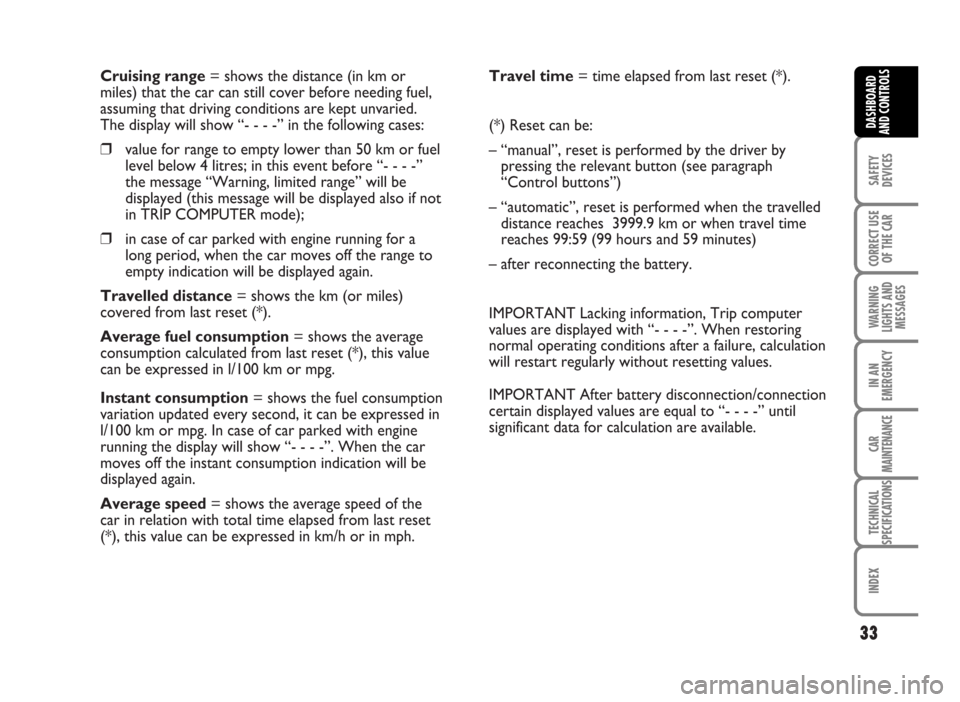
Cruising range= shows the distance (in km or
miles) that the car can still cover before needing fuel,
assuming that driving conditions are kept unvaried.
The display will show “- - - -” in the following cases:
❒value for range to empty lower than 50 km or fuel
level below 4 litres; in this event before “- - - -”
the message “Warning, limited range” will be
displayed (this message will be displayed also if not
in TRIP COMPUTER mode);
❒in case of car parked with engine running for a
long period, when the car moves off the range to
empty indication will be displayed again.
Travelled distance= shows the km (or miles)
covered from last reset (*).
Average fuel consumption= shows the average
consumption calculated from last reset (*), this value
can be expressed in l/100 km or mpg.
Instant consumption= shows the fuel consumption
variation updated every second, it can be expressed in
l/100 km or mpg. In case of car parked with engine
running the display will show “- - - -”. When the car
moves off the instant consumption indication will be
displayed again.
Average speed= shows the average speed of the
car in relation with total time elapsed from last reset
(*), this value can be expressed in km/h or in mph.Travel time= time elapsed from last reset (*).
(*) Reset can be:
– “manual”, reset is performed by the driver by
pressing the relevant button (see paragraph
“Control buttons”)
– “automatic”, reset is performed when the travelled
distance reaches 3999.9 km or when travel time
reaches 99:59 (99 hours and 59 minutes)
– after reconnecting the battery.
IMPORTANT Lacking information, Trip computer
values are displayed with “- - - -”. When restoring
normal operating conditions after a failure, calculation
will restart regularly without resetting values.
IMPORTANT After battery disconnection/connection
certain displayed values are equal to “- - - -” until
significant data for calculation are available.
33
SAFETY
DEVICES
CORRECT USE
OF THE CAR
WARNING
LIGHTS AND
MESSAGES
IN AN
EMERGENCY
CAR
MAINTENANCE
TECHNICAL
SPECIFICATIONS
INDEX
DASHBOARD
AND CONTROLS
Page 66 of 314
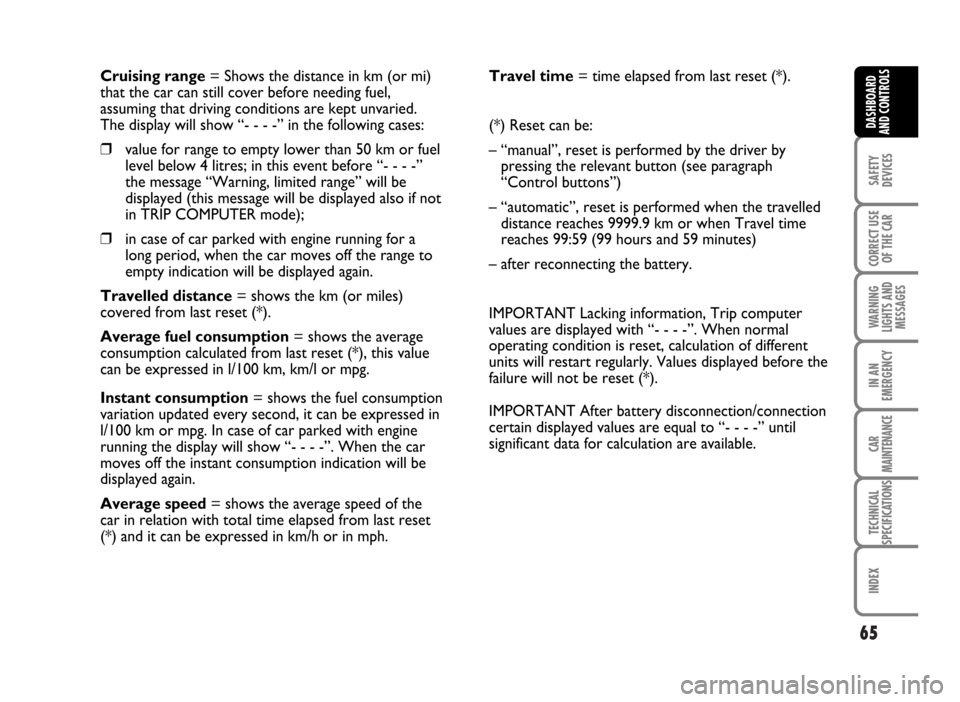
65
SAFETY
DEVICES
CORRECT USE
OF THE CAR
WARNING
LIGHTS AND
MESSAGES
IN AN
EMERGENCY
CAR
MAINTENANCE
TECHNICAL
SPECIFICATIONS
INDEX
DASHBOARD
AND CONTROLS
Cruising range= Shows the distance in km (or mi)
that the car can still cover before needing fuel,
assuming that driving conditions are kept unvaried.
The display will show “- - - -” in the following cases:
❒value for range to empty lower than 50 km or fuel
level below 4 litres; in this event before “- - - -”
the message “Warning, limited range” will be
displayed (this message will be displayed also if not
in TRIP COMPUTER mode);
❒in case of car parked with engine running for a
long period, when the car moves off the range to
empty indication will be displayed again.
Travelled distance= shows the km (or miles)
covered from last reset (*).
Average fuel consumption= shows the average
consumption calculated from last reset (*), this value
can be expressed in l/100 km, km/l or mpg.
Instant consumption= shows the fuel consumption
variation updated every second, it can be expressed in
l/100 km or mpg. In case of car parked with engine
running the display will show “- - - -”. When the car
moves off the instant consumption indication will be
displayed again.
Average speed= shows the average speed of the
car in relation with total time elapsed from last reset
(*) and it can be expressed in km/h or in mph.Travel time= time elapsed from last reset (*).
(*) Reset can be:
– “manual”, reset is performed by the driver by
pressing the relevant button (see paragraph
“Control buttons”)
– “automatic”, reset is performed when the travelled
distance reaches 9999.9 km or when Travel time
reaches 99:59 (99 hours and 59 minutes)
– after reconnecting the battery.
IMPORTANT Lacking information, Trip computer
values are displayed with “- - - -”. When normal
operating condition is reset, calculation of different
units will restart regularly. Values displayed before the
failure will not be reset (*).
IMPORTANT After battery disconnection/connection
certain displayed values are equal to “- - - -” until
significant data for calculation are available.
Page 91 of 314
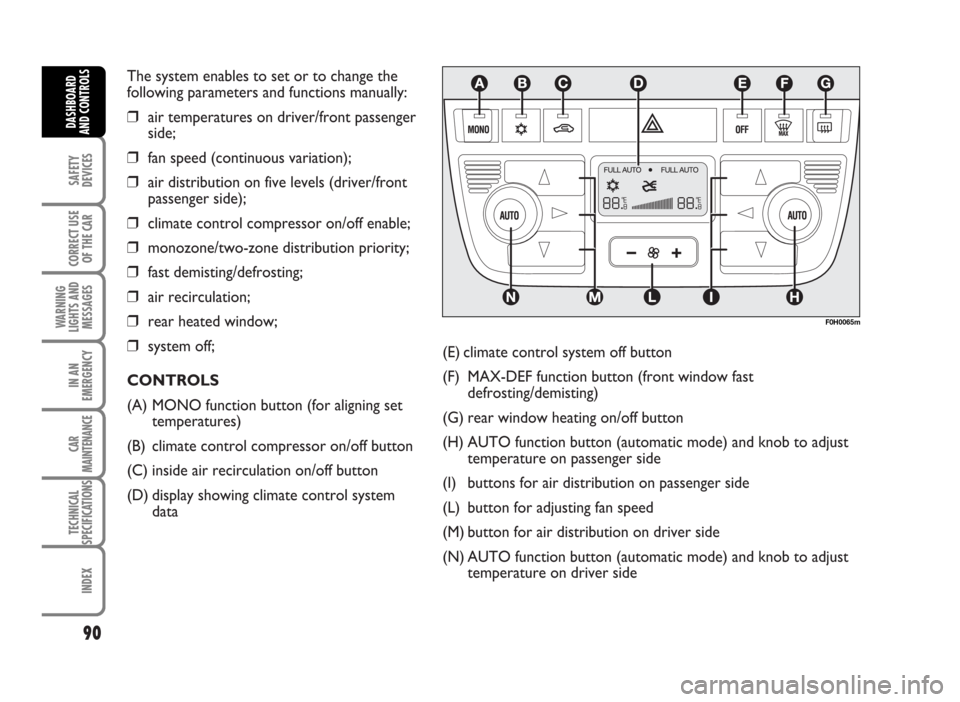
The system enables to set or to change the
following parameters and functions manually:
❒air temperatures on driver/front passenger
side;
❒fan speed (continuous variation);
❒air distribution on five levels (driver/front
passenger side);
❒climate control compressor on/off enable;
❒monozone/two-zone distribution priority;
❒fast demisting/defrosting;
❒air recirculation;
❒rear heated window;
❒system off;
CONTROLS
(A) MONO function button (for aligning set
temperatures)
(B) climate control compressor on/off button
(C) inside air recirculation on/off button
(D) display showing climate control system
data(E) climate control system off button
(F) MAX-DEF function button (front window fast
defrosting/demisting)
(G) rear window heating on/off button
(H) AUTO function button (automatic mode) and knob to adjust
temperature on passenger side
(I) buttons for air distribution on passenger side
(L) button for adjusting fan speed
(M) button for air distribution on driver side
(N) AUTO function button (automatic mode) and knob to adjust
temperature on driver side
90
SAFETY
DEVICES
CORRECT USE
OF THE CAR
WARNING
LIGHTS AND
MESSAGES
IN AN
EMERGENCY
CAR
MAINTENANCE
TECHNICAL
SPECIFICATIONS
INDEX
DASHBOARD
AND CONTROLS
F0H0065m
Page 151 of 314
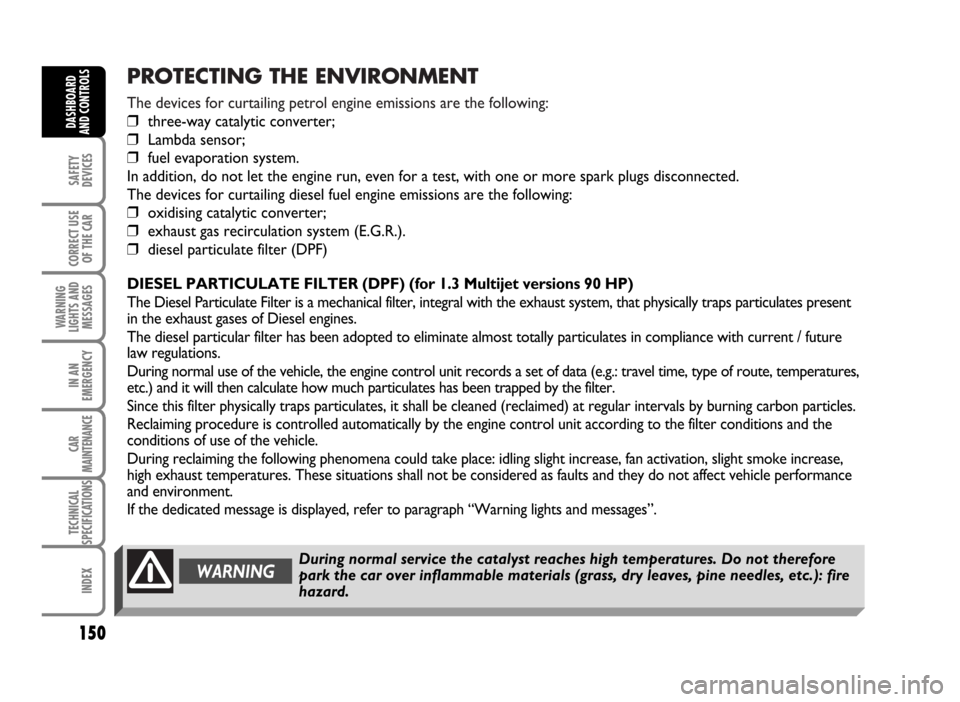
PROTECTING THE ENVIRONMENT
The devices for curtailing petrol engine emissions are the following:
❒three-way catalytic converter;
❒Lambda sensor;
❒fuel evaporation system.
In addition, do not let the engine run, even for a test, with one or more spark plugs disconnected.
The devices for curtailing diesel fuel engine emissions are the following:
❒oxidising catalytic converter;
❒exhaust gas recirculation system (E.G.R.).
❒diesel particulate filter (DPF)
DIESEL PARTICULATE FILTER (DPF) (for 1.3 Multijet versions 90 HP)
The Diesel Particulate Filter is a mechanical filter, integral with the exhaust system, that physically traps particulates present
in the exhaust gases of Diesel engines.
The diesel particular filter has been adopted to eliminate almost totally particulates in compliance with current / future
law regulations.
During normal use of the vehicle, the engine control unit records a set of data (e.g.: travel time, type of route, temperatures,
etc.) and it will then calculate how much particulates has been trapped by the filter.
Since this filter physically traps particulates, it shall be cleaned (reclaimed) at regular intervals by burning carbon particles.
Reclaiming procedure is controlled automatically by the engine control unit according to the filter conditions and the
conditions of use of the vehicle.
During reclaiming the following phenomena could take place: idling slight increase, fan activation, slight smoke increase,
high exhaust temperatures. These situations shall not be considered as faults and they do not affect vehicle performance
and environment.
If the dedicated message is displayed, refer to paragraph “Warning lights and messages”.
150
SAFETY
DEVICES
CORRECT USE
OF THE CAR
WARNING
LIGHTS AND
MESSAGES
IN AN
EMERGENCY
CAR
MAINTENANCE
TECHNICAL
SPECIFICATIONS
INDEX
DASHBOARD
AND CONTROLS
During normal service the catalyst reaches high temperatures. Do not therefore
park the car over inflammable materials (grass, dry leaves, pine needles, etc.): fire
hazard.WARNING
Page 161 of 314
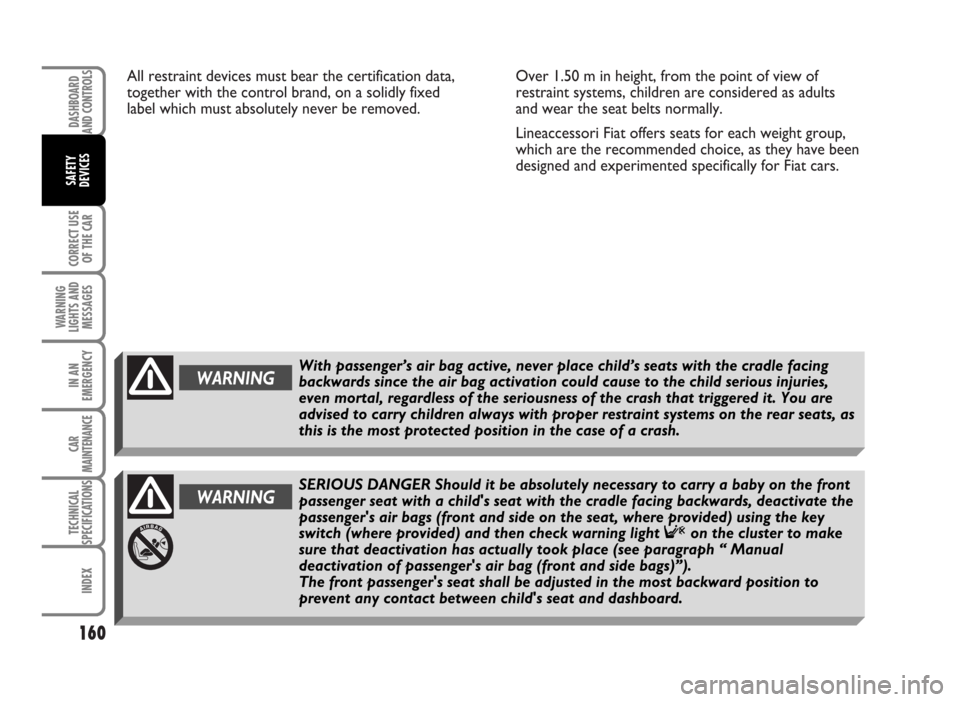
All restraint devices must bear the certification data,
together with the control brand, on a solidly fixed
label which must absolutely never be removed.Over 1.50 m in height, from the point of view of
restraint systems, children are considered as adults
and wear the seat belts normally.
Lineaccessori Fiat offers seats for each weight group,
which are the recommended choice, as they have been
designed and experimented specifically for Fiat cars.
160
CORRECT USE
OF THE CAR
WARNING
LIGHTS AND
MESSAGES
IN AN
EMERGENCY
CAR
MAINTENANCE
TECHNICAL
SPECIFICATIONS
INDEX
DASHBOARD
AND CONTROLS
SAFETY
DEVICES
WARNINGWith passenger’s air bag active, never place child’s seats with the cradle facing
backwards since the air bag activation could cause to the child serious injuries,
even mortal, regardless of the seriousness of the crash that triggered it. You are
advised to carry children always with proper restraint systems on the rear seats, as
this is the most protected position in the case of a crash.
WARNINGSERIOUS DANGER Should it be absolutely necessary to carry a baby on the front
passenger seat with a child's seat with the cradle facing backwards, deactivate the
passenger's air bags (front and side on the seat, where provided) using the key
switch (where provided) and then check warning light Fon the cluster to make
sure that deactivation has actually took place (see paragraph “ Manual
deactivation of passenger's air bag (front and side bags)”).
The front passenger's seat shall be adjusted in the most backward position to
prevent any contact between child's seat and dashboard.
Page 287 of 314
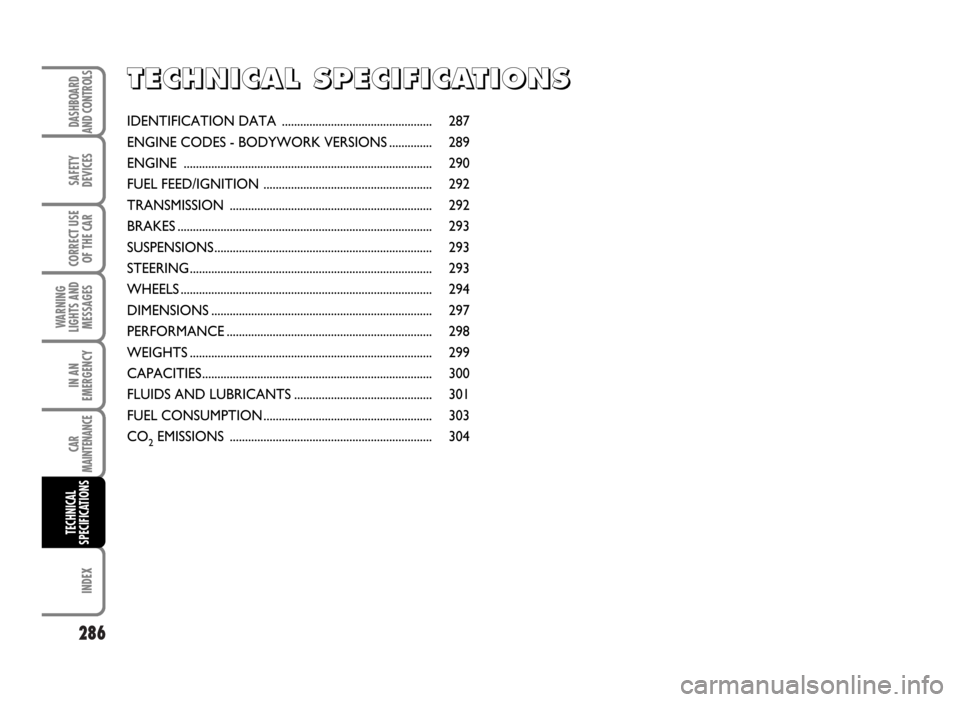
286
SAFETY
DEVICES
CORRECT USE
OF THE CAR
WARNING
LIGHTS AND
MESSAGES
IN AN
EMERGENCY
CAR
MAINTENANCE
INDEX
DASHBOARD
AND CONTROLS
TECHNICAL
SPECIFICATIONS
T T
E E
C C
H H
N N
I I
C C
A A
L L
S S
P P
E E
C C
I I
F F
I I
C C
A A
T T
I I
O O
N N
S S
IDENTIFICATION DATA ................................................. 287
ENGINE CODES - BODYWORK VERSIONS .............. 289
ENGINE ................................................................................. 290
FUEL FEED/IGNITION ....................................................... 292
TRANSMISSION .................................................................. 292
BRAKES ................................................................................... 293
SUSPENSIONS ....................................................................... 293
STEERING............................................................................... 293
WHEELS .................................................................................. 294
DIMENSIONS ........................................................................ 297
PERFORMANCE ................................................................... 298
WEIGHTS ............................................................................... 299
CAPACITIES........................................................................... 300
FLUIDS AND LUBRICANTS ............................................. 301
FUEL CONSUMPTION ....................................................... 303
CO
2EMISSIONS .................................................................. 304
Page 288 of 314
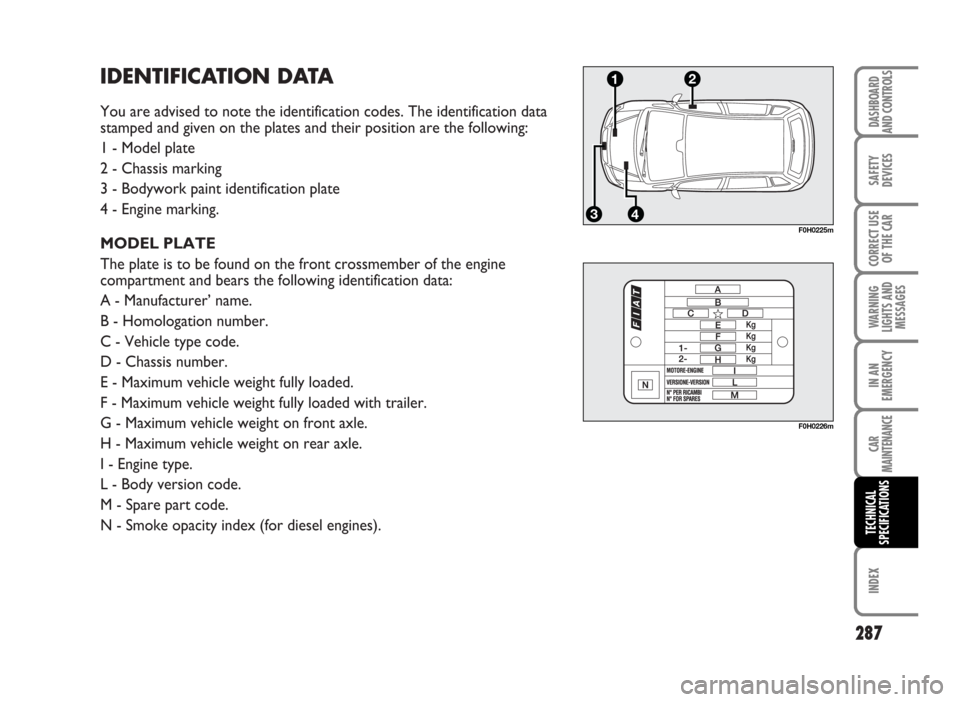
IDENTIFICATION DATA
You are advised to note the identification codes. The identification data
stamped and given on the plates and their position are the following:
1 - Model plate
2 - Chassis marking
3 - Bodywork paint identification plate
4 - Engine marking.
MODEL PLATE
The plate is to be found on the front crossmember of the engine
compartment and bears the following identification data:
A - Manufacturer’ name.
B - Homologation number.
C - Vehicle type code.
D - Chassis number.
E - Maximum vehicle weight fully loaded.
F - Maximum vehicle weight fully loaded with trailer.
G - Maximum vehicle weight on front axle.
H - Maximum vehicle weight on rear axle.
I - Engine type.
L - Body version code.
M - Spare part code.
N - Smoke opacity index (for diesel engines).
287
SAFETY
DEVICES
CORRECT USE
OF THE CAR
WARNING
LIGHTS AND
MESSAGES
IN AN
EMERGENCY
CAR
MAINTENANCE
INDEX
DASHBOARD
AND CONTROLS
TECHNICAL
SPECIFICATIONS
4
21
3F0H0225m
F0H0226m
Page 289 of 314
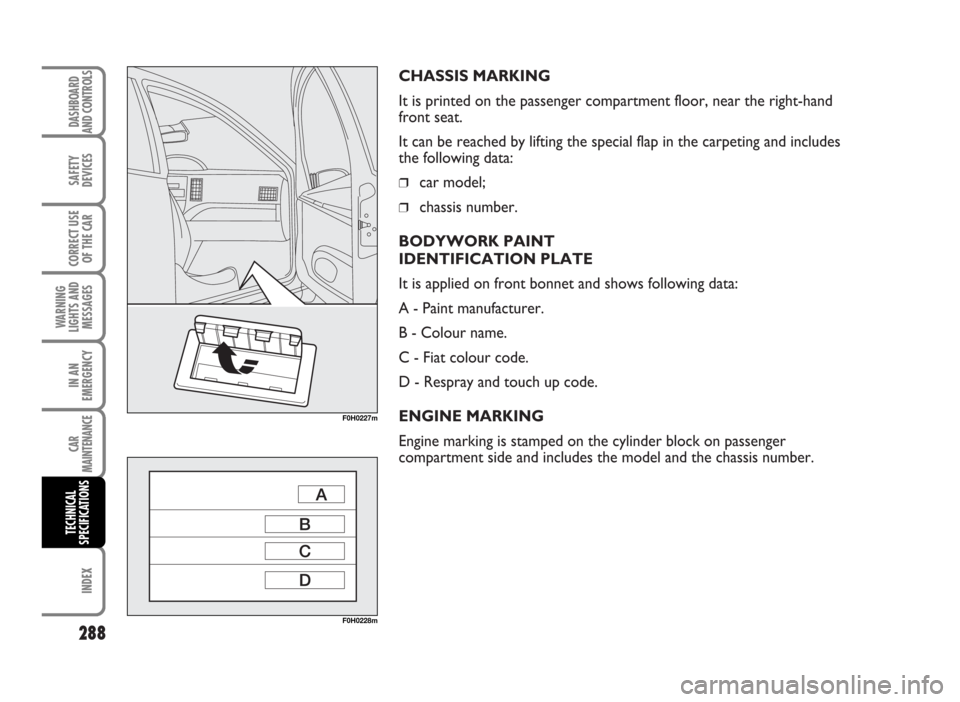
CHASSIS MARKING
It is printed on the passenger compartment floor, near the right-hand
front seat.
It can be reached by lifting the special flap in the carpeting and includes
the following data:
❒car model;
❒chassis number.
BODYWORK PAINT
IDENTIFICATION PLATE
It is applied on front bonnet and shows following data:
A - Paint manufacturer.
B - Colour name.
C - Fiat colour code.
D - Respray and touch up code.
ENGINE MARKING
Engine marking is stamped on the cylinder block on passenger
compartment side and includes the model and the chassis number.
288
SAFETY
DEVICES
CORRECT USE
OF THE CAR
WARNING
LIGHTS AND
MESSAGES
IN AN
EMERGENCY
CAR
MAINTENANCE
INDEX
DASHBOARD
AND CONTROLS
TECHNICAL
SPECIFICATIONS
F0H0228m
F0H0227m
Page 307 of 314
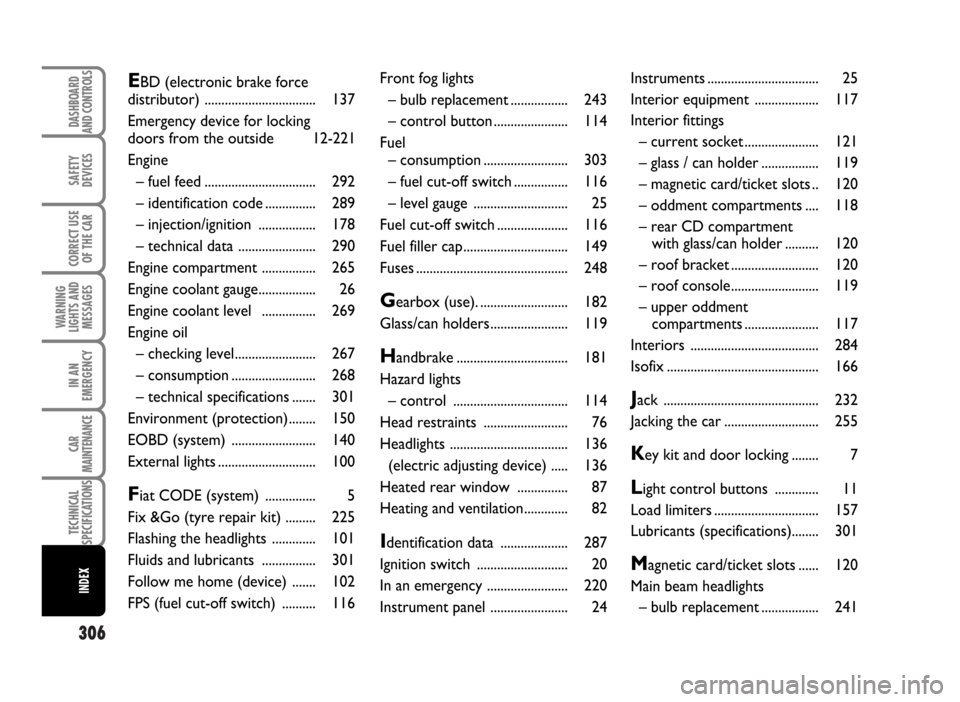
306
SAFETY
DEVICES
CORRECT USE
OF THE CAR
WARNING
LIGHTS AND
MESSAGES
IN AN
EMERGENCY
CAR
MAINTENANCE
TECHNICAL
SPECIFICATIONS
DASHBOARD
AND CONTROLS
INDEX
EBD (electronic brake force
distributor) ................................. 137
Emergency device for locking
doors from the outside 12-221
Engine
– fuel feed ................................. 292
– identification code ............... 289
– injection/ignition ................. 178
– technical data ....................... 290
Engine compartment ................ 265
Engine coolant gauge................. 26
Engine coolant level ................ 269
Engine oil
– checking level........................ 267
– consumption ......................... 268
– technical specifications ....... 301
Environment (protection)........ 150
EOBD (system) ......................... 140
External lights ............................. 100
Fiat CODE (system) ............... 5
Fix &Go (tyre repair kit) ......... 225
Flashing the headlights ............. 101
Fluids and lubricants ................ 301
Follow me home (device) ....... 102
FPS (fuel cut-off switch) .......... 116Front fog lights
– bulb replacement ................. 243
– control button ...................... 114
Fuel
– consumption ......................... 303
– fuel cut-off switch ................ 116
– level gauge ............................ 25
Fuel cut-off switch ..................... 116
Fuel filler cap............................... 149
Fuses ............................................. 248
Gearbox (use). .......................... 182
Glass/can holders ....................... 119
Handbrake ................................. 181
Hazard lights
– control .................................. 114
Head restraints ......................... 76
Headlights ................................... 136
(electric adjusting device) ..... 136
Heated rear window ............... 87
Heating and ventilation............. 82
Identification data .................... 287
Ignition switch ........................... 20
In an emergency ........................ 220
Instrument panel ....................... 24Instruments ................................. 25
Interior equipment ................... 117
Interior fittings
– current socket ...................... 121
– glass / can holder ................. 119
– magnetic card/ticket slots .. 120
– oddment compartments .... 118
– rear CD compartment
with glass/can holder .......... 120
– roof bracket .......................... 120
– roof console.......................... 119
– upper oddment
compartments ...................... 117
Interiors ...................................... 284
Isofix ............................................. 166
Jack .............................................. 232
Jacking the car ............................ 255
Key kit and door locking ........ 7
Light control buttons ............. 11
Load limiters ............................... 157
Lubricants (specifications)........ 301
Magnetic card/ticket slots ...... 120
Main beam headlights
– bulb replacement ................. 241